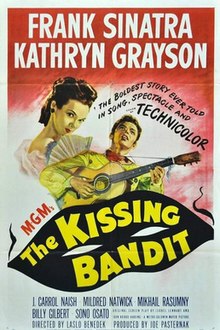The Kissing Bandit (film)
| The Kissing Bandit | |
|---|---|
 | |
| Directed by | László Benedek |
| Written by | Isobel Lennart |
| Produced by | Joe Pasternak |
| Starring | |
| Cinematography | Robert Surtees |
| Edited by | Adrienne Fazan |
| Music by | George Stoll |
| Color process | Technicolor |
Production company | Metro-Goldwyn-Mayer |
| Distributed by | Metro-Goldwyn-Mayer |
Release date |
|
Running time | 100 minutes |
| Country | United States |
| Language | English |
| Budget | $3,291,000[1][2] |
| Box office | $1,381,000[1] |
The Kissing Bandit is a 1948 American comedy musical Western film directed by László Benedek. It stars Frank Sinatra and Kathryn Grayson, with J. Carrol Naish in a supporting role, and Ricardo Montalbán, Ann Miller and Cyd Charisse in cameo roles.
Plot[edit]
This article needs an improved plot summary. (February 2024) |
In the early nineteenth century, Ricardo, the son of a robber known as the Kissing Bandit, is a shy, Boston-bred young man who does not know how to sit on a horse. He falls for the daughter of the Spanish Governor of California.
Cast[edit]
- Frank Sinatra as Ricardo
- Kathryn Grayson as Teresa
- J. Carrol Naish as Chico
- Mildred Natwick as Isabella
- Mikhail Rasumny as Don Jose
- Billy Gilbert as General Felipe Torro
- Sono Osato as Bianca
- Clinton Sundberg as Colonel Gomez
- Carleton G. Young as Count Ricardo Belmonte
- Ricardo Montalbán as Fiesta Specialty Dancer
- Ann Miller as Fiesta Specialty Dancer
- Cyd Charisse as Fiesta Specialty Dancer
- Sally Forrest as Fiesta Specialty Dancer
- Edna Skinner as Juanita
- Vicente Gómez as Mexican Guitarist
- Mitchell Lewis as Fernando (uncredited)
Songs[edit]
- "Tomorrow Means Romance" (music by Nacio Herb Brown; lyrics by William Katz) – Sung by Kathryn Grayson
- "What's Wrong With Me?" (music by Nacio Herb Brown; lyrics by Earl K. Brent) – Sung by Kathryn Grayson, Frank Sinatra
- "If I Steal a Kiss" (music by Nacio Herb Brown; lyrics by Edward Heyman) – Sung by Frank Sinatra; reprised by Kathryn Grayson
- "I Like You" (music by Nacio Herb Brown; lyrics by Edward Heyman) – Sung and danced by Sono Osato
- "Siesta" (music by Nacio Herb Brown; lyrics by Edward Heyman) – Sung by Frank Sinatra
- "Dance of Fury" (music by Nacio Herb Brown) – Danced by Ricardo Montalban, Cyd Charisse and Ann Miller
- "Señorita" (music by Nacio Herb Brown; lyrics by Earl K. Brent) – Sung by Frank Sinatra and Kathryn Grayson
- "Love Is Where You Find It" (music by Nacio Herb Brown; lyrics by Earl K. Brent) – Sung by Kathryn Grayson
Reception[edit]
The film was a financial disaster, earning $969,000 in the US and Canada and $412,000 overseas, resulting in a loss to MGM of $2,643,000. This made it one of the least successful musicals in MGM history.[1][3][4]
It was reviewed unfavorably in Picturegoer: "The progress of [the] romance is uninspired and very dull. The one worthwhile performance comes from J. Carrol Naish as The Kissing Bandit's henchman."[5]
On an episode of the radio show, Light Up Time, Sinatra referred to himself as "star of The Kissing Bandit, the script of which somebody should have put a match to."[citation needed]
Australian armed robbery[edit]
On December 10, 1950, a 19-year-old Estonian Australian immigrant named Peeter Pedaja hijacked a motorcycle while brandishing a toy gun somewhere on the road near Gympie, Queensland. Heading farther south, he forced a car to stop between Landsborough and Nambour, and demanded money from the driver before speeding off, eventually being arrested by Queensland police. He told the court that he meant no harm, and was inspired to "do something unusual" after watching The Kissing Bandit.[6][7] Pedaja was released on a suspended sentence, and was eventually proclaimed "The Kissing Bandit in Real Life" by the Australian media.[8]
References[edit]
- ^ a b c Glancy, H. Mark (1992). "MGM film grosses, 1924–1948: The Eddie Mannix Ledger". Historical Journal of Film, Radio and Television. 12 (2). Los Angeles: 127–144. doi:10.1080/01439689200260081.
- ^ Another source puts the cost at $2.5 million Variety February 1948
- ^ Variety says it earned $1.8 million see "Top Grossers of 1948", Variety 5 January 1949 p 46
- ^ "Top Grossers of 1949". Variety. January 4, 1950. p. 59.
- ^ Picturegoer, 4 June 1949, p. 16
- ^ "Kissing Bandit Was His Model, Youth Explains". Brisbane Telegraph. February 23, 1951. Retrieved December 29, 2023.
- ^ "Film Inspired Hope in Young New Australian". The Herald, Melbourne. February 23, 1951. Retrieved December 29, 2023.
- ^ "'Kissing Bandit' in Real Life". Maryborough Chronicle. February 24, 1951. Retrieved December 29, 2023.
External links[edit]
- 1948 films
- Metro-Goldwyn-Mayer films
- Films produced by Joe Pasternak
- Films directed by László Benedek
- American Western (genre) musical films
- 1940s Western (genre) musical films
- Films set in the 19th century
- American historical musical films
- 1940s historical musical films
- 1940s English-language films
- 1940s American films
